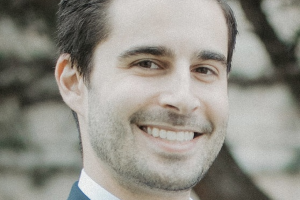
Connor Glass came to the Johns Hopkins University School of Medicine in 2019 for a research fellowship in plastic surgery to pursue his dream of helping people with traumatic limb injuries use their appendages again. But as he did more research on how technology was assisting patients, as they adapted to prosthetics, braces and exoskeletons, he began to dream bigger.
“I knew that I didn’t want to just participate in these research studies as a surgeon and help one patient at a time,” he says. “I really wanted to do something that affects people on a larger scale.”
So, Glass passed on a residency program to establish a startup, Phantom Neuro, a platform technology that gives lifelike control to prosthetics. The company announced a $3-million-plus seed funding round in March 2022 and added board members, including Robert Lord, a partner at LionBird Ventures and co-founder of Protenus, another Johns Hopkins spinout.
Phantom Neuro’s system aims to recreate — wirelessly — for prosthetics users the natural signaling pathways people with intact limbs use to control muscle movement. Sensors on muscles transmit the movement signals to a phone or other internet-enabled device; the signals are then converted into commands for the targeted prosthetic in real time.
Glass envisions Phantom Neuro bridging the gap between cutting-edge lab research on human-machine interfacing and how prosthetics function in the real world, which he says in some cases has not changed since the Civil War.
Glass patented the technology through Johns Hopkins Technology Ventures and participated in the I-Corps program for entrepreneurs, offered through the FastForward startup incubator. Brian Stansky, FastForward’s senior director, who has worked with Glass, called this new technology “truly game-changing.”
“It has been great to see how his persistent efforts over the past few years have progressed in terms of technical development, funding and company formation,” says Stansky. “I look forward to watching Connor’s work advance — with the hope that it leads to a point where fully functional replacement limbs becomes reality.”
Phantom Neuro’s platform is designed to work with any kind or brand of prosthetic. However, it could also be used by people with intact limbs and mobility issues to help them gain functionality or confidence in using their arms or legs, Glass says.
“It’s not that you’re having to control your movement on your phone by pressing a button or thinking about walking forward,” he says. “It’s that you’re actually walking forward as if your legs are intact. And that, in turn, just naturally will cause your legs to walk how you want them to.”
Glass developed the technology with Nitish Thakor, a professor of biomedical engineering and neurology at the Johns Hopkins University School of Medicine; Sami Tuffaha, an assistant professor of plastic and reconstructive surgery; and Jaimie Shores, clinical director of the Hand/Arm Transplant Program at the Johns Hopkins Comprehensive Transplant Center, and an investor in Phantom Neuro.
The company has performed testing of a wired prototype version of its sensors and is building out a wireless version of the technology. Glass credits JHTV with both helping him make connections and encouraging him to reach out to prosthetic manufacturers, exoskeleton researchers and potential investors to pick their brains and explore potential relationships.
“You have to be master of your own destiny,” he says. “I think you have to go after what you want, and you have to not be afraid to be told ‘no’ or to fail.”
Although Glass has relocated to Austin, Texas, he remains in close contact with his Johns Hopkins collaborators.
“Probably the most amazing thing that I’ve experienced at Hopkins is the collaborative nature of people,” said Glass, who attended medical school at the University of Oklahoma. “You might think people would be very insular and protective of their work, but it’s such a collaborative environment.”
Looking ahead, Glass says he hopes to have Phantom Neuro’s technology available to actual patients in a few years , most likely for upper-limb amputees, whom the company plans to target first. Research into human-machine interfacing is relatively new, he notes, and with most work now focused on the brain and spinal cord, he is eager to see what innovations lie ahead for limbs.
“My passion in this field centers on how we can harness technology to improve functional outcomes,” he says. “I started Phantom Neuro with the intention of having as big of an impact on the field as I could.”